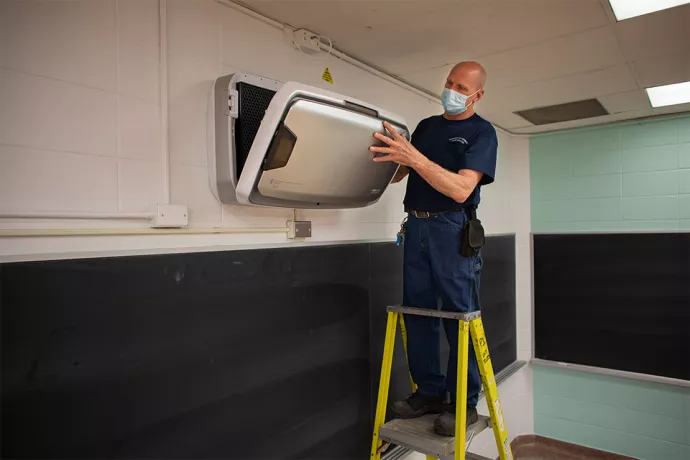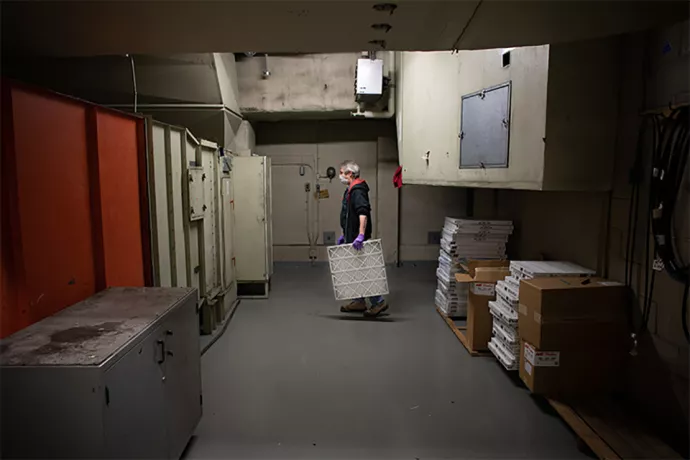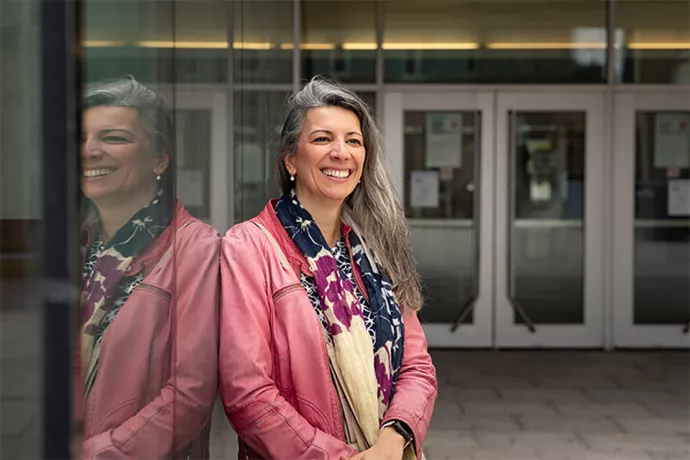
U of T assesses, upgrades classroom ventilation as it plans for in-person learning this fall
The University of Toronto is assessing the ventilation in its classrooms and making upgrades to heating, ventilation and air conditioning (HVAC) equipment where necessary to ensure a high standard of safety amid the COVID-19 pandemic.
As U of T plans for an eventual return to in-person classes subject to relevant public health guidelines and government regulations, classrooms used for in-person teaching across all three campuses will be equipped to allow at least six equivalent air changes per hour – the same standard applied to health-care settings such as patient examination rooms and walk-in clinics. U of T consulted external experts when adopting the standard, which reflects the current consensus in the field about optimal ventilation for such spaces.
While most classrooms are expected to be able to achieve the standard with minor adjustments to existing ventilation systems, those that can’t will be fitted with local air filtration devices equipped with high-efficiency particulate air (HEPA) filters to achieve the standard, otherwise they will not be used.
The university has chosen air purifiers that are highly rated, quiet and effective to ensure that they don't interfere with other classroom equipment and teaching. More than 100,000 such units have been installed in U.S. public school classrooms, as well as in classrooms across Ontario, since the onset of the pandemic, according to the manufacturer.
Ron Saporta, U of T’s chief operating officer, property services and sustainability, said the classroom assessments and upgrades are part of the university’s ongoing review of pandemic response protocols.
“The guidelines around ventilation have evolved throughout the pandemic and we’ve made sure to stay abreast of them,” Saporta said, adding that the university is paying particularly close attention to classroom ventilation.
“Unlike offices where it’s one person or a small group of people – and you know exactly who – you don’t have the same element of control in classrooms, so we have to put in other measures to account for the larger number of people coming in and out of classrooms compared to other spaces.
“Some other spaces, including teaching labs, research labs and clinics, are held to more rigorous ventilation standards due to the nature of the space and the activities they support.”
Saporta noted that high-quality ventilation is one of many precautions U of T is taking to curb the spread of COVID-19 once in-person classes can safely resume. Others include changing physical layouts to facilitate physical distancing, increasing the frequency of cleaning and disinfecting and mandating the wearing of non-medical masks in indoor spaces.
“HVAC can play a role in helping reduce the spread of COVID-19, but it’s just one piece of the puzzle,” he said.
“It’s vital that members of the U of T community continue to heed public health guidelines such as wearing a mask, physical distancing and staying home if you feel sick.”

Jelena Vulovic-Basic, senior manager, operations and maintenance at U of T Facilities & Services, said U of T staff and external engineering professionals assessed classrooms’ existing ventilation standards based on guidelines published by the leading HVAC authority, the American Society of Heating, Refrigerating and Air Conditioning Engineers (ASHRAE), and a review of other guidelines and standards.
“We needed to calculate how many equivalent air changes per hour we have in our classrooms with current systems,” she said. “We did this by measuring air flow in classrooms and assessing each of the air-handling units.”

The classroom HVAC assessments are the latest measure put in place by U of T to try and reduce the risk of transmission of COVID-19 by ensuring its spaces meet public health and industry standards. For example, the university upgraded its air filtration systems last summer by replacing MERV-8 filters with higher-rated MERV-13 filters. A higher MERV rating, or Minimum Efficiency Reporting Value, indicates a filter’s ability to capture a higher percentage of smaller particles from the air.
In addition, U of T’s ventilation systems undergo regular maintenance and inspections to ensure the air distributed into indoor spaces is clean, fresh and flowing properly.
“In the context of the pandemic, we’ve been on top of recommended COVID-19 ventilation safety measures,” Vulovic-Basic said.
Vulovic-Basic praised U of T staff for their work behind the scenes.
“This has been an enormous undertaking with a tremendous amount of effort, with everybody bending sideways and backwards to help get the classrooms ready,” she said.
